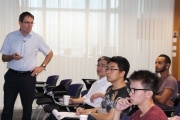Better Materials for Energy Related Applications via Inorganic Synthesis
Abstract
All governmental institutions throughout the world commonly agree that energy is the most important challenge that our planet will have to face over the next 50 years as we have to double our production without increasing the CO2 release. Great hopes are placed in the use of renewable energies coming from the sun, wind, and biomass and so on. Therefore our success towards this energy transition will depend on our inability to manage, transport, convert and store electricity at both large scale and low cost.
The use of renewable energies enlists numerous conversion technologies such as photovoltaics, thermoelectrics or wind turbines, storage technologies such as batteries, supercapacitors or fuel cells or transport technologies relying on superconductors. Therefore a common denominator to all of these technologies is that their performance is always limited by the performance of the materials, illustrating that the material is essential. So the lectures will focus on chemical means to manipulate, arrange, and assemble atoms, via either high and low temperature synthesis routes so as to elaborate, prepare and design new materials for energy related applications. The energy hungry classical ceramic approaches enlisting either higher temperatures or high pressures will first be described. Afterwards, the speaker will present energy-saving synthesis processes, falling under the general discipline of “chimie douce”, enlisting hydro(solvo)(iono)-thermal approaches relying on topotactic reactions realized via the use of microwave and sonification.
Schedule
25 Sep 2015 (Fri)
- 10:00 - 11:00 am
Introduction to Inorganic Synthesis: Strategies Pertaining to the Ceramic Approach
- 2:30 - 3:30 pm
Inorganic Materials Obtained at Either High Temperatures or High Pressures
12 Oct 2015 (Mon)
- 10:00 - 11:00 am
Inorganic Materials Prepared by Either Molten Salts or by Reactive Ball Milling
- 2:30 - 3:30 pm
Inorganic Materials Assembled by Hydro(solvo)(iono)-processes
14 Oct 2015 (Wed)
- 10:00 - 11:00 am
Inorganic Materials Designed by “Chimie Douce” via Topotactic Reactions
- 2:00 - 3:00 pm
Inorganic Materials Synthesized by Sol-gel Methods
About the speaker
Prof. Jean-Marie Tarascon received his PhD in Solid State Chemistry from the University of Bordeaux in 1981. Most of his career was spent in the US, first at Cornell University in 1980, then Bell Laboratory and Bellcore until 1994. Prof Tarascon is currently Professor of Chemistry of Materials and Energy at the Collège de France. He is also the director of the Research Network on Electrochemical Energy Storage, a research and technology transfer network devoted to energy storage devices initiated by the French Ministry of Higher Education and Research.
Prof. Tarascon’s field of research is in the development of new techniques for the synthesis of new electronic materials (superconductors, ferroelectrics, fluoride glasses and rechargeable batteries materials) for new solid state electronic devices, and for relating crystal structure to electronic, optical, and magnetic properties. His work has primarily focused on some electronic properties of Chevrel phases as well as their ability to insert or deinsérer alkali ions. He has made outstanding contributions in the field of superconductivity and was the original proponent of the thin and flexible plastic lithium ion battery based on a strong and highly resistant hybrid polymer system that is presently commercialized. As the head of the Institute of Chemistry of Picardie and coordinator of the European Research Institute for battery research (ALISTORE-ERI), he is exploiting new Li reactivity concepts such as conversion or displacement reactions, and novel electrodes designs for the next generation of Li-ion batteries based on nano-electrodes/electrolyte components.
Elected a Foreign Member of the Royal Society in 2014, Prof. Tarascon is also a Member of the American Chemical Society, Electrochemical Society and Materials Research Society. He is the author of about 69 patents and more than 520 publications, as well as the recipient of many awards, the most recent of which are the Volta Medal, the 2004 "ISI AWARD", nomination to the French Academy of Sciences in 2005, and the UPJV gold medalist in 2008.



